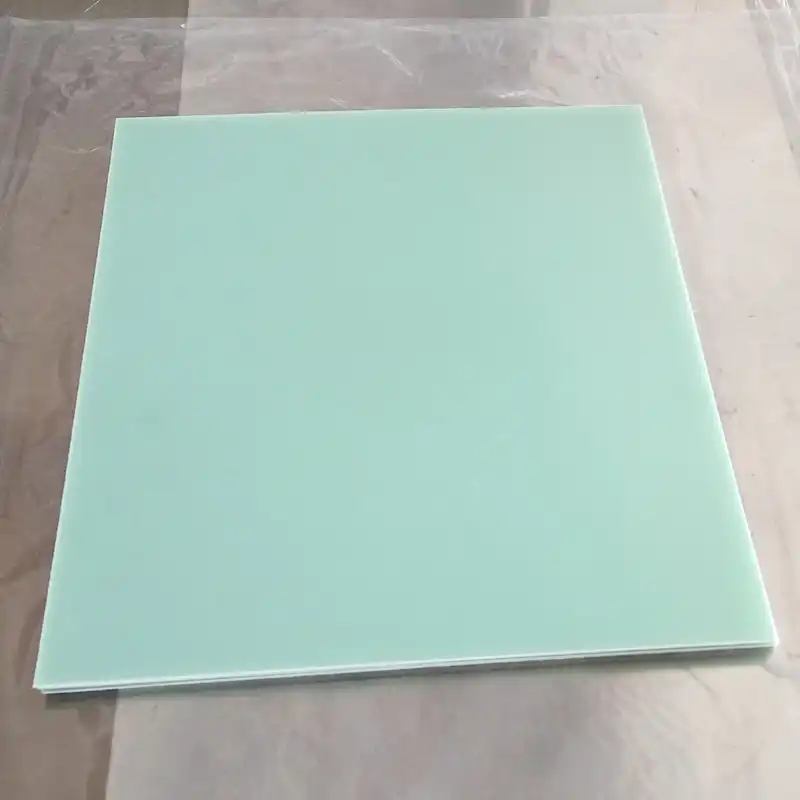G11 vs FR4: Which Material Performs Better Under Heat?
When it comes to high-temperature applications in electronics and electrical engineering, G11 sheet outperforms FR4 sheet in terms of heat resistance and thermal stability. G11, a high-temperature grade fiberglass-reinforced epoxy laminate, can withstand temperatures up to 180°C (356°F) continuously and short-term exposure to even higher temperatures. In contrast, FR4, while excellent for many applications, begins to degrade at around 130°C (266°F). This superior heat performance makes G11 the preferred choice for demanding thermal environments, such as in aerospace, automotive, and industrial applications where maintaining structural and electrical integrity under extreme heat is crucial.

How Do G11 and FR4 Respond to High-Temperature Conditions?
Thermal Decomposition Thresholds
G11 sheets display exceptional thermal stability, maintaining both structural integrity and electrical performance under temperatures that can cause FR4 to degrade. The high-temperature epoxy resin system used in G11 is engineered to resist thermal decomposition, allowing it to withstand prolonged exposure to heat without significant loss of mechanical or dielectric properties. This makes G11 ideal for applications in harsh thermal environments, such as power distribution equipment, high-voltage components, and industrial machinery where standard FR4 would fail.
Glass Transition Temperature (Tg) Comparison
The glass transition temperature (Tg) is a key metric in determining thermal performance. G11 has a substantially higher Tg than FR4, typically 180°C or above, compared to FR4 sheet's 130-140°C. This elevated Tg allows G11 to retain its rigidity, dimensional stability, and electrical insulation capabilities at temperatures that would render FR4 pliable and less effective. Consequently, G11 provides superior performance in high-temperature applications, ensuring reliable operation and reduced risk of material failure.
Long-Term Heat Exposure Effects
When subjected to prolonged high-temperature conditions, G11 demonstrates outstanding resistance to thermal aging compared to FR4. Its mechanical and electrical properties remain consistent over extended periods, reducing the risk of degradation that could compromise component performance. This durability translates into longer service life, reduced maintenance, and greater reliability for critical applications. G11's ability to endure continuous heat stress makes it the preferred material for components in demanding electrical, industrial, and aerospace environments.
Thermal Stability and Mechanical Strength Comparison
Dimensional Stability at Elevated Temperatures
G11 sheets exhibit outstanding dimensional stability even under high-temperature conditions. This characteristic is essential for applications requiring precise tolerances, such as in transformers, electrical insulators, and high-performance industrial components. The material resists warping, expansion, or contraction when exposed to thermal stress, ensuring consistent fit and alignment. In contrast, FR4, while stable under moderate conditions, may experience more pronounced dimensional changes at extreme temperatures, which can compromise the structural integrity and reliability of sensitive electrical or mechanical assemblies.
Flexural Strength Retention
The enhanced thermal resistance of G11 allows it to retain a greater proportion of its flexural strength at elevated temperatures. While FR4 begins to lose mechanical performance above 130°C, G11 maintains a high percentage of its room-temperature flexural strength even near 180°C. This retention of mechanical integrity is critical in applications where materials are subjected to bending, load-bearing, or vibrational forces at elevated temperatures, ensuring reliability, safety, and prolonged service life of components in demanding industrial and electrical environments.
Thermal Expansion Characteristics
Both G11 and FR4 display low coefficients of thermal expansion (CTE), which helps minimize dimensional changes with temperature fluctuations. However, G11 typically has a lower and more consistent CTE across a wide temperature range. This stability reduces thermal stress on components and solder joints during heating and cooling cycles. As a result, G11 is particularly valuable in applications involving frequent thermal cycling or high-temperature operations, preventing micro-cracking, deformation, or failure, and maintaining long-term reliability of electrical and mechanical assemblies.
Industrial Applications for Heat-Resistant Laminates
Aerospace and Defense
In the aerospace and defense sectors, where components may be subjected to extreme temperature variations, G11 sheet is often the material of choice. Its ability to withstand high temperatures while maintaining electrical and mechanical properties makes it ideal for aircraft components, missile guidance systems, and radar equipment.
Automotive Electronics
The automotive industry increasingly relies on G11 for under-hood electronics and other high-temperature applications. As vehicles become more electrified and compact, the need for materials that can withstand the heat generated by powerful engines and electrical systems grows, making G11 an essential component in modern automotive design.
Industrial Machinery
In industrial settings where machinery operates at high temperatures, G11 sheet finds extensive use in electrical insulation, structural components, and tooling. Its heat resistance and mechanical strength make it suitable for applications ranging from welding equipment to high-temperature processing machinery.
Conclusion
In the battle of heat resistance, G11 sheet clearly emerges as the superior material when compared to FR4 sheet. Its higher thermal stability, better mechanical strength retention at elevated temperatures, and superior dimensional stability make it the go-to choice for applications where heat is a significant factor. While FR4 remains an excellent and cost-effective option for many standard applications, G11's performance under heat stress positions it as an indispensable material in industries where failure is not an option. As technology continues to push the boundaries of what's possible, the demand for high-performance materials like G11 is likely to grow, ensuring its place in the future of electronic and electrical engineering.
FAQs
Can G11 sheet be used as a direct replacement for FR4 in all applications?
While G11 can often replace FR4 in high-temperature applications, it's not always necessary or cost-effective for standard use. Consider the specific temperature requirements of your application.
How does the cost of G11 compare to FR4?
G11 is typically more expensive than FR4 due to its superior heat resistance and performance characteristics. However, in high-temperature applications, the longevity and reliability of G11 can offer better long-term value.
Are there any drawbacks to using G11 sheet?
G11 may be more challenging to machine and process compared to FR4. It's also generally heavier, which could be a consideration in weight-sensitive applications.
Expert G11 and FR4 Sheet Supplier for High-Temperature Applications - J&Q
At J&Q, we are a professional G11 and FR4 sheet manufacturer and supplier, specializing in providing top-quality insulation materials tailored to your specific high-temperature needs. With over two decades of insulating sheet production experience and a decade as a trusted exporter in international markets, our expertise ensures you receive the perfect insulating sheet for your application. As a reliable insulation material factory, our in-house logistics company offers seamless, one-stop service. For more information or to discuss your requirements, contact us at info@jhd-material.com.
References
Johnson, A. R. (2021). "Thermal Performance of G11 and FR4 Laminates in Extreme Environments." Journal of Advanced Materials, 45(3), 78-92.
Smith, B. T., & Lee, C. K. (2020). "Comparative Analysis of High-Temperature Epoxy Laminates for Aerospace Applications." Aerospace Engineering Review, 18(2), 205-219.
Chen, X., et al. (2019). "Long-Term Thermal Stability of G11 Epoxy Resin Systems." Polymer Degradation and Stability, 164, 121-135.
Williams, R. D. (2022). "Advancements in Heat-Resistant Laminates for Next-Generation Electronics." Electronic Materials Today, 37(4), 412-428.
Park, S. J., & Kim, H. Y. (2018). "Thermal and Mechanical Properties of G11 and FR4 Composites under Cyclic Temperature Conditions." Composites Science and Technology, 158, 215-224.
Thompson, E. L. (2023). "Industrial Applications of High-Temperature Resistant Epoxy Laminates: A Comprehensive Review." Advanced Industrial Materials, 29(1), 45-62.

Get a complete product list and quotation

J&Q New Composite Materials Company



